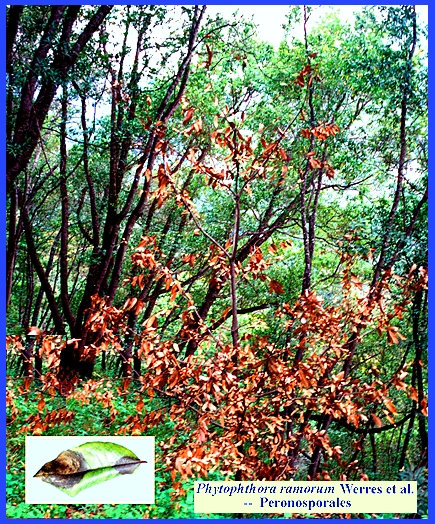File: <suddenoakdeath > Pooled References GENERAL
INDEX [Navigate to MAIN MENU ]
|
Sudden Oak Death Phytophthora
ramorum Werres et al.
(Peronosporales) |
------ CLICK on photo to enlarge. To search
for Subject Matter, Depress Ctrl/F
----------------------------------------------------------------------------------------------------------------------------------
|
How the
pathogen is transmitted is uncertain, but insects are not believed to be
involved. Infection results in spores
that may be spread by wind and rain.
Plant nurseries may also inadvertently be instrumental in spreading
the infection. P. ramorum is now a major threat to California
woodlands. Symptoms
are cankers on a tree's trunk, foliage dieback, and eventual death. There is a wide host range including over
40 California tree and shrub species with variable susceptibility to
infection. Some trees, like tanoak (Lithocarpus densiforus) and coast live
oak (Quercus agrifolia), show
high systemic infection and high mortality.
The most susceptible species exhibit browning foliage and death within
one year. Others species like
California bay laurel (Umbellularia
californica), show only foliar lesions and mild twig dieback, and
they continue to spread the pathogen.
The United States Forest Service estimates that by 2022, Sudden Oak Death killed over 1 million
trees in central & northern California. REFERENCES: Brasier C. & J.
Webber. 2010. Sudden larch death. Nature 466: 824-825. Cobb R. C., R. K. Meentemeyer, & D. M. Rizzo.
2010. Apparent competition in canopy trees determined by pathogen
transmission rather than susceptibility.
Ecology 91 (2): 327-333. Davidson J. M., H. A. Patterson, & D. M.
Rizzo. 2008. Sources of inoculum for Phytophthora ramorum in a redwood
forest. Phytopathology 98:860-866. Davidson J. M., H. A. Patterson, A. C. Wickl, E. J. Fichtner & D. M. Rizzo. 2011.
Forest type influences transmission of Phytophthora ramorum in California oak woodands. Phytopathology 101: 492-501. Eyre, C. A., K. J.
Hayden, M. Kozanitas, N. J. Grünwald
& M. Garbelotto. 2014. Lineage, temperature, & host species
have interacting effects on lesion development. In: Phytophthora ramorum. Plant Disease
98: 1717-1727. Fichtner, E. J.,
S. C. Lynch & D. M. Rizzo. 2007. Detection,
distribution, sporulation, & survival of Phytophthora
ramorum in a California redwood-tanoak forest soil. Phytopathology 97: 1366-1375. Frankel, S. J.
2008. Sudden oak death & Phytophthora ramorum in the USA: a
management challenge. Australasian
Plant Pathology 37: 19-25. Goheen, E. M., E.
Hansen, A. Kanaskie, N. Osterbauer, J. Parke, J. Pscheidt &
G. Chastagner. 2006. Sudden Oak Death & Phytophthora ramorum: a guide for forest
managers, Christmas tree growers, & forest-tree nursery operators in
Oregon & Washington. Extension
Publication EM 8877, Oregon State University. 16 pages. Grünwald, N. J., M. Garbelotto, E. M. Goss, K. Heungens
& S. Prospero. 2012. Emergence of the sudden oak death pathogen
Phytophthora ramorum. Trends in Microbiology 20: 131-138 Grünwald, N. J., E. M. Goss & C. M. Press. 2008.
Phytophthora ramorum: a
pathogen with a remarkably wide host range causing sudden oak death on oaks
& ramorum blight on woody ornamentals.
Molecular Plant Pathology 9:
729-740. Kamvar, Z. N., M. M. Larsen, A. M. Kanaskie, E. M.
Hansen & N. J. Grünwald. 2015. Spatial
& temporal analysis of population of the sudden oak death pathogen in
Oregon forests. Phytopathology
105: 982-989. Kline, N., S. Navarro & D. C. Shaw. 2018.
Sudden oak death: prevention, recognition, restoration. Extension Publication EM 9216, Oregon State
University. 12 pp. Parke, J. L. & C. Lewis. 2007. Root
& stem infection of rhododendron from potting medium infested with Phytophthora ramorum. Plant Disease 91: 1265-1270. Peterson, E., E. Hansen & J. Hulbert. 2014.
Source or sink? The role of soil & water borne inoculum in the
dispersal of Phytophthora ramorum
in Oregon tanoak forests. Forest
Ecology & Management 322: 48-57. Rizzo, D. M. & M. Garbelotto. 2003.
Sudden oak death: endangering California & Oregon forest
ecosystems. Front. Ecol. Environ. 1: 197–204. Venette, R. C. & S .D. Cohen. 2006.
Potential climatic suitability for establishment of Phytophthora ramorum within the
contiguous United States. Forest
Ecology & Management 231: 18-26. Vercauteren, A., M. Riedel, M. Maes, S. Werres &
K. Heungens. 2012. Survival of Phytophthora ramorum in Rhododendron root balls & in
rootless substrates. Plant Pathology
62 (1): 166-176. Webber, J F., M. Mullett & C. M. Brasier.
2010. Dieback & mortality of
plantation Japanese larch (Larix kaempferi)
associated with infection by Phytophthora
ramorum. New Disease
Reports 22: 19. Werres, S., R. Marwitz, W. A.
Man, T. Veld, A. W. A. M. de
Cock, P. J. M. Bonants, M. de Weerdt, K. Themann, E.
Ilieva & R. P. Baayen. 2001. Phytophthora ramorum sp. nov., a new
pathogen on Rhododendron & Viburnum.
Mycological Research 105:
1155-1165. |
